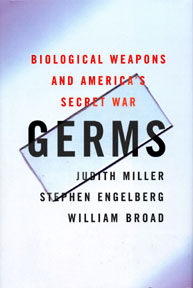Related Research Articles

Biological warfare, also known as germ warfare, is the use of biological toxins or infectious agents such as bacteria, viruses, insects, and fungi with the intent to kill, harm or incapacitate humans, animals or plants as an act of war. Biological weapons are living organisms or replicating entities. Entomological (insect) warfare is a subtype of biological warfare.

The Biological Weapons Convention (BWC), or Biological and Toxin Weapons Convention (BTWC), is a disarmament treaty that effectively bans biological and toxin weapons by prohibiting their development, production, acquisition, transfer, stockpiling and use. The treaty's full name is the Convention on the Prohibition of the Development, Production and Stockpiling of Bacteriological (Biological) and Toxin Weapons and on their Destruction.

Judith Miller is an American journalist and commentator known for her coverage of Iraq's Weapons of Mass Destruction (WMD) program both before and after the 2003 invasion, which was later discovered to have been based on inaccurate information from the intelligence community. She worked in The New York Times' Washington bureau before joining Fox News in 2008.

Mobile weapons laboratories are bioreactors and other processing equipment to manufacture and process biological weapons that can be moved from location to location either by train or vehicle. Allegations that Iraq had access to such equipment were made by the United States in the lead-up to the Iraq War. Subsequent investigations failed to find any evidence of Iraq having access to a mobile weapons lab.
Audrey Gillan is a British journalist and screenwriter.

William J. Broad is an American science journalist, author and a Senior Writer at The New York Times.
The United States biological weapons program officially began in spring 1943 on orders from U.S. President Franklin Roosevelt. Research continued following World War II as the U.S. built up a large stockpile of biological agents and weapons. Over the course of its 27-year history, the program weaponized and stockpiled the following seven bio-agents :
Project Bacchus was a covert investigation by the Defense Threat Reduction Agency US Defense Department to determine whether it is possible to construct a bioweapons production facility with off-the-shelf equipment.

The Soviet Union covertly operated the world's largest, longest, and most sophisticated biological weapons program, thereby violating its obligations as a party to the 1972 Biological Weapons Convention. The program began in the 1920s and lasted until at least September 1992 but has possibly been continued by Russia after that.
This article deals with activities of the U.S. Central Intelligence Agency, specifically dealing with arms control, weapons of mass destruction (WMD) and weapons proliferation. It attempts to look at the process of tasking and analyzing, rather than the problem itself, other than whether the CIA's efforts match its legal mandate or assists in treaty compliance. In some cases, the details of a country's programs are introduced because they present a problem in analysis. For example, if Country X's policymakers truly believe in certain history that may not actually be factual, an analyst trying to understand Country X's policymakers needs to be able to understand their approach to an issue.
Entomological warfare (EW) is a type of biological warfare that uses insects to interrupt supply lines by damaging crops, or to directly harm enemy combatants and civilian populations. There have been several programs which have attempted to institute this methodology; however, there has been limited application of entomological warfare against military or civilian targets, Japan being the only state known to have verifiably implemented the method against another state, namely the Chinese during World War II. However, EW was used more widely in antiquity, in order to repel sieges or cause economic harm to states. Research into EW was conducted during both World War II and the Cold War by numerous states such as the Soviet Union, United States, Germany and Canada. There have also been suggestions that it could be implemented by non-state actors in a form of bioterrorism. Under the Biological and Toxic Weapons Convention of 1972, use of insects to administer agents or toxins for hostile purposes is deemed to be against international law.
Project Jefferson was a covert U.S. Defense Intelligence Agency program designed to determine if the current anthrax vaccine was effective against genetically modified bacteria. The program's legal status under the 1972 Biological Weapons Convention (BWC) is disputed.

Germs: Biological Weapons and America's Secret War is a 2001 book written by New York Times journalists Judith Miller, Stephen Engelberg, and William Broad. It describes how humanity has dealt with biological weapons, and the dangers of bioterrorism. It was the 2001 New York Times #1 Non-Fiction Bestseller the weeks of October 28 and November 4.
The Stepnogorsk Scientific and Technical Institute for Microbiology, also known as the Scientific Experimental and Production Base, was one of the premier biological warfare facilities operated by the Soviet Union. It was the only Biopreparat facility to be built outside of Russia proper, and one of the few ever visited officially by Western experts. As of 1998 the site conducted civilian biological research overseen by director Vladimir Bugreyev. At the time the United States Department of State and the U.S. Civilian Research & Development Foundation provided significant funds supporting civilian research at Stepnogorsk.
Before the 20th century, the use of biological agents took three major forms:
The United States biological defense program—in recent years also called the National Biodefense Strategy—refers to the collective effort by all levels of government, along with private enterprise and other stakeholders, in the United States to carry out biodefense activities.

Riley D. Housewright was an American microbiologist who conducted research on germ warfare. Having been assigned to the Fort Detrick laboratory in the mid-1940s and appointed scientific director in 1956, Housewright played a major role in the development of bioweapons for a proposed attack on Cuba during the Cuban Missile Crisis. In 1966, he was appointed president of the American Society for Microbiology. He left Fort Detrick in 1970 following President Nixon's moratorium on US bioweapons research, and later published several books on water safety for the National Academy of Sciences. In the 1980s, Housewright became executive director of the American Society for Microbiology. He died in Frederick, Maryland, in 2003.
The Chinese biological weapons program is a biological weapons program reported to have been active in the 1980s, and suspected by some governments and security analysts to remain covertly active. China is currently a signatory of the Biological Weapons Convention (BWC) and Chinese officials have stated that China has never engaged in biological activities with offensive military applications. China was reported to have had an active biological weapons program in the 1980s. Members of the US intelligence community heavily suspect that the state of China had, as of 2015, at least 42 facilities that may be involved in research, development, production, or testing of biological agents.
In March 2022, during Russia's invasion of Ukraine, Russian officials falsely claimed that public health facilities in Ukraine were "secret U.S.-funded biolabs" purportedly developing biological weapons, which was debunked as disinformation by multiple media outlets, scientific groups, and international bodies. The claim was amplified by China's Ministry of Foreign Affairs and Chinese state media, and was also promoted by QAnon and gained support among far-right groups in the U.S.
References
- 1 2 3 4 5 Enemark, Christian. Disease and Security: Natural Plagues and Biological Weapons in East Asia, (Google Books), Routledge, 2007, pp. 173-75, ( ISBN 0415422345).
- 1 2 Miller, Judith, Engelberg, Stephen and Broad, William J. "U.S. Germ Warfare Research Pushes Treaty Limits", The New York Times , September 4, 2001. Retrieved January 6, 2009.
- 1 2 Tucker, Jonathan B. "Biological Threat Assessment: Is the Cure Worse Than the Disease? Archived 2008-05-17 at the Wayback Machine ", Arms Control Today, October 2004. Retrieved January 6, 2009.